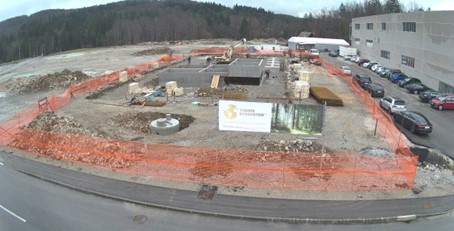We have already reported on the upcoming giant Themis Ecosystem. Its forty-member team is working tirelessly on the new integrated platform. As a reminder, Themis Ecosystem combines breakthrough, technologically advanced, but proven and already functional green technologies, which will be in demand for at least a few more decades.
The main focus is currently on the production of green electricity. Project Phoenix8 will transform waste plastic and worn-out tires into electricity with a 98% economic efficiency, without air or water emissions. The second project, the Biomass Ultima plant, will generate electricity from wood biomass, with the highest efficiency on the market.
The Themis Ecosystem project is one of a kind and really inspired us, so we are following it closely. In the beginning, when there was only the white paper of the Project Phoenix8 project, plans for Biomass Ultima, and the idea for Themis Ecosystem, some skeptics doubted that such a project could even see the light of day. But founder Roberto Hroval, who already has dozens of implemented innovative projects, has never questioned that the project is feasible and will transform the industry.
In the time of Covid-19, plans have changed a bit. The team took advantage of the closing-down time and vastly improved the strategy. With new approaches, they shortened seven years of development to one year.
The building of the first factory has already begun
The location of the first factory to produce green energy from waste is in Slovenia, EU, where the company already has its research lab.

Today, the last skeptics have fallen silent when all the machines are already waiting in the nearby warehouse, and the construction site is taking on a different look every day. The team started building the factory quietly, without grand openings and media fanfare. In fact, only investors who are regularly informed about the events know the exact course of events.
Although some “experts” predicted the construction would take up to a year, the factory was supposed to be built in just six months, given the schedule. Current developments indicate that the factory could be finished within three months of construction or at the end of this year.
The first factory will serve as a proof-of-concept
Designing and building the first factory is the most challenging, as it involves overcoming inertia and proving that the technology works as predicted. Projects of this type, which represent an absolute novelty in the economic space and local community, find it challenging to get support, financial impetus, and permits. More often than not, it all comes down to the founder’s charisma and ability to finance the project, acquire investors, and convince authorities.
Hroval managed to overcome all obstacles. Very soon, he will be able to show potential new investors for the upcoming factories the so-called first “driver,” which will serve as a ground zero facility. “The first factory will serve as a proof-of-concept,” he said, “a service center and know-how point for new installations. More significant business partners who need larger installations are already looking forward to the new factories.”

Once they are convinced and satisfied, knowing that the system is working according to expectations and plans, interest in the expansion will propel Themis Ecosystem to the stars.
Shortly after the kick-off of the first factory, a rapid expansion follows. In addition to the multiplication of the first two “drivers,” Biomass Ultima and Project Phoenix8, several supporting projects are already waiting in the background. They will supplement the structure and contribute to optimal results.
The founder explains that the focus is not only on industry and market success; Themis Ecosystem also aims for other innovative solutions. They will contribute to society’s development and the environment’s protection.
The new approach is changing the industry, bringing innovation and positivity
The long-term strategy behind the Themis Ecosystem is to fully transform key industries, bring something positive to the local community, and substantially reduce global warming. The system can be considered a lighthouse, paving the way for the future.
One of the innovations is the connecting technology within the system, an innovative marketplace called Online Industry Exchange (OIX). It combines all products, raw materials, and negative CO2 the technologies produce into a common denominator in the form of an e-voucher. It is called Industrial Token or iTo. The product’s price, short-term and long-term profitability, and market supply and demand determine iTo’s value. The base currency for iTo is the US dollar, and the price of iTo changes according to mentioned factors.
Here’s where OIX’s role comes in. It will serve as a kind of raw material exchange, a classic approach to selling and buying products. And no, this is not a crypto exchange, and iTo has nothing to do with cryptocurrencies. The founder emphasized: “We are dealing with good, old raw materials or tangible assets.”
A green deal for all, says Roberto Hroval
The entire process works in a way that the technologies process the input raw material – plastic, wood waste, and worn-out tires – into valuable, commercially attractive goods: green electricity, organic carbon black, metals, etc. Due to the green process, negative CO2 is produced, which also has a market value.
The technologies create alternative energy while simultaneously reducing global warming. The entire output – a final product and CO2 reduction – is packaged in an e-voucher or iTo.
Supporters can trade iTos without intermediaries and commissions. They are available to ordinary people who do not need trading licenses, high amounts of investment capital, special licenses, trading knowledge, etc., to buy or sell.
Everything is transparent, uncomplicated, and understandable. “This is a green deal for all,” concludes Roberto Hroval, “the new economy and opportunity for the masses, not only for the selected wealthy people or elite investment companies. We allow everyone to support new but proven technologies with incredible economic potential from the start. And we are very proud of it.”

